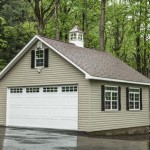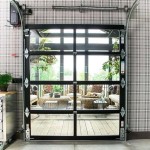How To Turn Your Garage Into a Gym: A Comprehensive Guide
Transforming a garage into a functional and motivating home gym is a popular project for fitness enthusiasts. It offers the convenience of working out on a personalized schedule without the expense and commitment of a commercial gym membership. However, a successful garage gym conversion requires careful planning, preparation, and execution. This article provides a comprehensive guide to navigating the process, ensuring the resulting space is safe, effective, and enjoyable.
### Key Point 1: Planning and PreparationBefore any physical modifications begin, a detailed plan is crucial. This stage involves assessing the existing garage space, defining fitness goals, and establishing a budget. Thorough planning ensures the final result aligns with individual needs and financial constraints.
The initial step involves a comprehensive assessment of the garage's dimensions. Accurate measurements of the length, width, and height are essential for determining equipment placement and identifying potential spatial limitations. Note the location of existing utilities, such as electrical outlets, lighting fixtures, and plumbing. Understanding the layout allows for strategic placement of equipment and modifications to accommodate power needs and ventilation requirements.
Defining fitness goals helps determine the appropriate equipment and layout. Consider the primary types of workouts the gym will accommodate: strength training, cardiovascular exercises, flexibility training, or a combination thereof. This informs the selection of equipment, such as weight racks, benches, treadmills, stationary bikes, or yoga mats. Prioritizing specific exercises helps optimize the space for those activities.
Establishing a realistic budget is crucial for controlling costs and preventing financial overextension. This involves researching the prices of equipment, flooring, lighting, ventilation, and any necessary construction materials. Prioritize essential equipment and consider purchasing used or refurbished items to reduce expenses. Allocate a portion of the budget for unexpected costs or modifications that may arise during the conversion process.
Alongside the physical dimensions, consider structural integrity. Inspect the garage door. If it's old, cumbersome, and rarely used, consider replacing it with an insulated wall and a separate entrance door for improved energy efficiency and security. Assess the condition of the garage walls and ceiling. Look for signs of water damage, cracks, or infestations that require repair before proceeding. A solid foundation and structurally sound walls are critical for a safe and durable gym environment.
Finally, don’t neglect local building codes and regulations. Some municipalities may require permits for structural modifications, electrical work, or plumbing installations. Research local ordinances to ensure compliance and avoid potential fines or legal issues. Consulting with a contractor or building inspector can help navigate these requirements.
### Key Point 2: Garage Modifications and ImprovementsThe next stage involves making the necessary modifications to transform the raw garage space into a functional and comfortable gym environment. This includes addressing flooring, ventilation, lighting, and potentially insulation.
Flooring is a fundamental aspect of a garage gym. Concrete floors are typically cold, hard, and unforgiving, making them unsuitable for many exercises. Consider installing specialized gym flooring options, such as rubber mats, interlocking foam tiles, or rolled rubber flooring. These materials provide cushioning, impact absorption, and sound dampening, enhancing comfort and safety. Evaluate the thickness and density of the flooring based on the intended use. Heavier weights and high-impact activities require thicker and more durable flooring options.
Adequate ventilation is vital for maintaining air quality and preventing the buildup of moisture and odors. Garages often lack proper ventilation, which can lead to discomfort and potential health issues. Consider installing an exhaust fan or a window air conditioner to improve airflow and regulate temperature. Opening the garage door or windows during workouts can also provide natural ventilation, but this may not be feasible in all climates or seasons.
Proper lighting is essential for creating a safe and motivating workout environment. Garages typically have inadequate lighting, which can make it difficult to see equipment and perform exercises correctly. Replace existing lighting fixtures with brighter, more energy-efficient options, such as LED shop lights or recessed lighting. Consider adding task lighting to specific areas, such as weightlifting stations or stretching zones. Natural light is also beneficial, so consider installing windows or a skylight if possible.
Depending on the climate and personal preferences, insulation may be necessary to regulate temperature and improve energy efficiency. Insulating the walls and ceiling can help keep the gym warm in the winter and cool in the summer, making it more comfortable to use year-round. Consider using fiberglass insulation, spray foam insulation, or rigid foam insulation. Insulating the garage door or replacing it with an insulated wall can also significantly improve temperature control.
Electrical Considerations are also vital. Examine the existing electrical outlets and wiring to ensure they can handle the power demands of gym equipment, such as treadmills, stationary bikes, and sound systems. If necessary, hire a qualified electrician to install additional outlets or upgrade the electrical panel. Ensure all wiring is properly grounded and protected to prevent electrical hazards.
### Key Point 3: Equipment Selection and LayoutChoosing the right equipment and arranging it effectively is critical for creating a functional and motivating gym space. This involves considering individual fitness goals, spatial limitations, and budget constraints.
Start by prioritizing essential equipment based on fitness goals. For strength training, consider a weight rack, barbell, weight plates, adjustable bench, and dumbbells. For cardiovascular exercises, consider a treadmill, stationary bike, elliptical machine, or rowing machine. For flexibility training, consider a yoga mat, foam roller, and resistance bands. Choose equipment that is durable, reliable, and appropriate for fitness level. Consider purchasing used or refurbished equipment to save money.
Optimize the layout to maximize space and functionality. Arrange equipment in a logical order, with heavier equipment near walls and open spaces for exercises that require more room. Create designated zones for different types of workouts, such as a weightlifting zone, a cardio zone, and a stretching zone. Ensure there is enough space to move around freely and safely between equipment. Consider using mirrors to visually expand the space and improve form during exercises.
Storage solutions are essential for keeping the gym organized and clutter-free. Install shelves, cabinets, or wall-mounted racks to store weights, dumbbells, resistance bands, and other accessories. Use storage bins or containers to keep smaller items organized. Designate a specific area for storing cleaning supplies and towels. A well-organized gym is more inviting and conducive to consistent workouts.
Consider the audio and visual aspects of the gym environment. Install a sound system to play music during workouts. Consider mounting a television to watch workout videos or stream entertainment. Choose a sound system and television that are appropriate for the size of the space and the intended use. Ensure the sound system is not too loud to disturb neighbors. A motivating audio and visual environment can enhance the workout experience.
Personalization is a key element in creating a space that inspires regular use. Add personal touches to make the gym feel more inviting and motivating. Display motivational posters, workout schedules, or personal fitness goals. Add plants or artwork to create a more visually appealing environment. Choose colors and décor that are energizing and inspiring. A personalized gym is more likely to be used consistently.

How To Turn Your Garage Into A Fitness Room

How To Turn Your Garage Into A Gym In 9 Easy Steps

How To Turn Your Garage Into A Fitness Room

Transforming An Empty Garage Into My Home Gym Setup Youtube

How To Turn Your Garage Into A Gym In 9 Easy Steps

How To Turn Your Garage Into A Home Gym For Family And Children Philadelphia Sports Nation

Man Turns 2 Car Garage Into Fully Kitted Out Home Gym Youtube

Turn Your Garage Into A Personal Gym And Stay Fit At Home

Converting Your Garage Into A Home Gym Select Doors

Turn Your Garage Into A Home Gym








